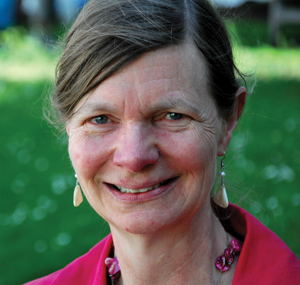Biography - Elspeth Garman
Biography | Publications | Bibliography | Videos | Slides | Articles | Obituary
Elspeth graduated in nuclear physics from Oxford University in 1979 and switched to biochemistry only later in her career, in 1987, when she joined the research staff at the Laboratory of Molecular Biophysics in Oxford. Since 1999 she has been faculty at the biochemistry department at Oxford University, where she now holds a position as Professor of Molecular Biophysics and as Director of the Systems Biology Programme at the Doctoral Training Centre. She is also Nicholas Kurti Senior Research Fellow in Macromolecular Crystallography and Tutor for Graduates at Brasenose College. Elspeth's research on cryo-cooling and radiation damage has had a profound impact on crystallography. Armed with a rigorous approach inherited from her physics background and her natural inventiveness, she optimized cryogenic tools and cooling parameters, introducing a methodical approach to cryo-cooling that greatly improved diffraction data. Since radiation damage emerged as a serious problem in crystallographic structure calculation in 2000, she has spearheaded the studies dedicated to the issue, introducing mitigating measures such as the use of small molecules as radical scavengers. She experimentally determined the maximum x-ray dose that can be delivered to a macromolecule before compromising its structure—a parameter that is now called "the Garman" limit—and presented a method to predict the lifetime of proteins exposed to certain radiation doses. She also pioneered the use of an online UV-visible spectrometer to detect the early signs of radiation damage. Besides these studies, she developed the proton induced x-ray emission (PIXE) technique, which allows precise identification of trace metal elements within a protein structure, and she determined the structure of many proteins involved in infectious diseases. Elspeth's value as a teacher and as a lecturer is appreciated at large. She is a very popular speaker at workshops all over the world, and her passion and enthusiasm for crystallography have left a long-lasting impression on her students and on her colleagues alike. She has tutored on 75 international courses, given 117 scientific lectures and 41 public lectures on crystallography, and organized 18 workshops. From 2009 to 2012 she was President of the British Crystallographic Association and from 2007-2011 she served as an Auditor of the European Crystallographic Association. The University of Oxford recognized her teaching qualities with the `Major Educator' personal teaching award in 2008; in 2014 she received the Most Acclaimed Lecturer Award for the Medical Sciences Division from the Oxford University Students Union. She is deeply involved in outreach programs aimed at increasing public scientific awareness both in a young and in an adult audience. For many years she has lectured at "Girls into Physics" conferences and she is often invited to give talks in schools all over the UK. She has been a speaker at the Royal Institution multiple times, and last year she delivered a public lecture at the Royal Albert Hall in occasion of the International Year of Crystallography. She is very comfortable with the media and the press: she has participated in over 40 TV and radio programmes and she has been often quoted in the main UK newspapers. In one of her most recent media appearances, an interview for the program "The Life Scientific" broadcasted by BBC4 in October 2014, she spoke at length about crystallography, about her life-long journey into experimental science...and about using her baby's hair to build the first cryo-loops. It is a most enjoyable conversation, which sums up her self-less attitude towards research and her desire to fuel progress in crystallography and in science in general; you can listen to it here: www.bbc.co.uk/programmes/b04kbjhg. The award presentation and lecture was Tuesday, July 26, 2016 at 8:00am |

